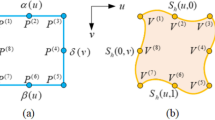Abstract
Modern computer graphics applications usually require high resolution object models for realistic rendering. However, it is expensive and difficult to deform such models in real time. In order to reduce the computational cost during deformations, a dense model is often manipulated through a simplified structure, called cage, which envelops the model. However, cages are usually built interactively by users, which is tedious and time-consuming. In this paper, we introduce a novel method that can build cages automatically for both 2D polygons and 3D triangular meshes. The method consists of two steps: 1) simplifying the input model with quadric error metrics and quadratic programming to build a coarse cage; 2) removing the self-intersections of the coarse cage with Delaunay partitions. With this new method, a user can build a cage to envelop an input model either entirely or partially with the approximate vertex number the user specifies. Experimental results show that, compared to other cage building methods with the same number of vertex, cages built by our method are more similar to the input models. Thus, the dense models can be manipulated with higher accuracy through our cages.
Similar content being viewed by others
References
Wei J, Lou Y. Feature preserving mesh simplification using feature sensitive metric. Journal of Computer Science and Technology, 2010, 25(3): 595–605.
Garland M, Heckbert P S. Surface simplification using quadric error metrics. In Proc. the 24th Annual Conference on Computer Graphics and Interactive Techniques, Los Angeles, USA, Aug. 3–8, 1997, pp.209–216.
Garland M, Heckbert P S. Simplifying surfaces with color and texture using quadric error metrics. In Proc. the Conference on Visualization 1998, Research Triangle Park, USA, Oct. 18-23, 1998, pp.263–269.
Hoppe H. New quadric metric for simplifying meshes with appearance attributes. In Proc. the Conference on Visualization 1999: Celebrating Ten Years, San Francisco, USA, Oct. 24–29, 1999, pp.59–66.
DeCoro C, Tatarchuk N. Real-time mesh simplification using the GPU. In Proc. Symposium on Interactive 3D Graphics (I3D), Seattle, USA, Apr. 30-May 2, 2007, pp.161–166.
Ju T, Schaefer S, Warren J. Mean value coordinates for closed triangular meshes. ACM Transactions on Graphics, 2005, 24(3): 561–566.
Floater M S. Mean value coordinates. Computer Aided Geometric Design, 2003, 20(1): 19–27.
Joshi P, Meyer M, DeRose T, Green B, Sanocki T. Harmonic coordinates for character articulation. In Proc. the ACM SIGGRAPH 2007, San Diego, USA, Aug. 4, 2007, Article No.71.
Lipman Y, Levin D, Cohen-Or D. Green coordinates. ACM Transactions on Graphics, 2008, 27(3): 1–10.
Ben-Chen M, Weber O, Gotsman C. Variational harmonic maps for space deformation. ACM Transactions on Graphics, 2009, 28(3): 1–11.
Weber O, Ben-Chen M, Gotsman C. Complex barycentric coordinates with applications to planar shape deformation. Computer Graphics Forum, 2009, 28(2): 587–597.
Cohen-Or D. Space deformations, surface deformations and the opportunities in-between. Journal of Computer Science and Technology, 2009, 24(1): 2–5.
Ju T, Zhou Q, Panne M, Cohen-Or D, Neumann U. Reusable skinning templates using cage-based deformations. ACM Transactions on Graphics, 2008, 27(5): 1–10.
Huang J, Chen L, Liu X, Bao H. Efficient mesh deformation using tetrahedron control mesh. Computer Aided Geometric Design, 2009, 26(6): 617–626.
Ben-Chen M, Weber O, Gotsman C. Spatial deformation transfer. In Proc. the 2009 ACM SIGGRAPH/Eurographics Symposium on Computer Animation, New Orleans, USA, Aug. 1–2, 2009, pp.67–74.
Chen L, Huang J, Sun H, Bao H. Technical section: Cagebased deformation transfer. Computers and Graphics, 2010, 34(2): 107–118.
Xian C, Lin H, Gao S. Automatic generation of coarse bounding cages from dense meshes. In Proc. the IEEE International Conference on Shape Modeling and Applications (SMI), Beijing, China, Jun. 26–28, 2009, pp.21–27.
Jung W, Shin H, Choi B K. Self-intersection removal in triangular mesh offsetting. Computer-Aided Design and Applications, 2004, 1(1–4): 477–484.
Cohen J, Varshney A, Manocha D, Turk G,Weber H, Agarwal P, Brooks F,WrightW. Simplification envelopes. In Proc. the 23rd Annual Conference on Computer Graphics and Interactive Techniques, New Orleans, USA, Aug. 4–9, 1996, pp.119–128.
Kazhdan M, Bolitho M, Hoppe H. Poisson surface reconstruction. In Proc. the Fourth Eurographics Symposium on Geometry Processing, Cagliari, Italy, Jun. 26–28, 2006, pp.61–70.
Hussain M. Efficient simplification methods for generating high quality LODs of 3D meshes. Journal of Computer Science and Technology, 2009, 24(3): 604–613.
Alexa M. Differential coordinates for local mesh morphing and deformation. The Visual Computer, 2003, 9(2): 105–114.
Cignoni P, Rocchini C, Scopigno R. Metro: Measuring error on simplified surfaces. Computer Graphics Forum, 1998, 17(2): 167–174.
Cignoni P.Metro. http://vcg.sourceforge.net/index.php/Metro. May 12, 2008 (cited on Sep. 13, 2010).
Author information
Authors and Affiliations
Corresponding author
Additional information
Supported by the NSFC-Guangdong Joint Fund under Grant Nos. U0735001, U0835004, U0935004, and the National Basic Research 973 Program of China under Grant No. 2011CB302204.
Electronic Supplementary Material
Below is the link to the electronic supplementary material.
Rights and permissions
About this article
Cite this article
Deng, ZJ., Luo, XN. & Miao, XP. Automatic Cage Building with Quadric Error Metrics. J. Comput. Sci. Technol. 26, 538–547 (2011). https://doi.org/10.1007/s11390-011-1153-4
Received:
Revised:
Published:
Issue Date:
DOI: https://doi.org/10.1007/s11390-011-1153-4




